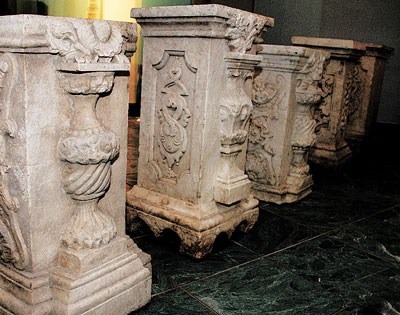|

SEVEN white marble columns from the ruins of the world-famous Yuanmingyuan Park in Beijing are expected to be returned to Beijing from a Norwegian museum this autumn.
The columns are among the 21 in the KODE Art Museums of Bergen, Norway, which houses one of the most extensive Chinese art collections in Europe. They were part of Yuanmingyuan ruins (also known as Old Summer Palace) in Beijing.
Yuanmingyuan was a complex of palaces and gardens built in the 18th and early 19th century. It was a place for emperors of the Qing Dynasty (1636-1911) to reside and handle government affairs. It was known for its extensive collection of gardens, architecture and other works of art. The palace was destroyed in the invasion of the British and French armies in the 19th century, and many of its treasures were taken abroad.
The columns will be returned to Peking University, and alumni Huang Nubo, a real estate developer, will donate 10 million Norwegian krone (US$1.65 million) to the museum, according to Chinese-language newspapers.
Born in 1956, Huang is the founder of Zhongkun Group Co., which mainly invests in real estate and holiday resort industries. He was ranked as 9th on the Hurun Philanthropy List in 2009, and has donated more than 1 billion yuan (US$165 million) to Peking University since 1990.
According to an agreement signed by the KODE museum and Huang, the museum would return the columns after Huang made the donation.
However, concerns were raised when the news was released.
“It is not a return if the columns go to the university instead of Yuanmingyuan,” said Liu Yang, a member of the Yuanmingyuan Society. “Giving them to the university is like changing the collector of the columns from one to another. It is acceptable to give them to the National Museum of China as it is the highest-level museum in China. It is meaningless if they go to Peking University.”
Liu claims that Huang made the donation and gave the columns to the university to gain fame and attention. “They are not very precious. Yuanmingyuan used to have more than 1,000 columns of the kind. There are some which still stand now. He picked the columns because these were the only thing which definitely belonged to the palace,” Liu said.
However, Huang retorts that he trusted the university over Yuanmingyuan. “It is said that the management department of the palace did a very poor job in protecting the relics of the palace. They could not even prevent visitors from writing things or spilling ink on the columns. I did not trust them,” Huang said.
Huang also denied the accusation that he is only seeking fame. “I made money by working hard. I did not tell anybody about it. The whole story was revealed by the New York Times. It was not me who announced the agreement,” Huang said.
Huang said that he just wanted to bring cultural and historical relics back to China, in order to make a contribution to his country. “I did not do these because of the values of the columns. I did it for our history and for the importance of taking back our lost treasures,” he said.
Xie Chensheng, who was one of the draftsmen for China’s cultural relic protection law, held another opinion. “I am always against the activity of getting back these cultural relics by purchasing,” he said. “These businessmen have high hopes, but it’s a shame to buy our own relics back.”
“According to the international treaty and our current policy, we have the right to get back these relics. But we can not purchase them as it turns illegal activities into a legal move,” he said.
However, Huang does not see this as truly a purchase. “It is a kind of cultural exchange. I support their construction of the museum and they give our relics back,” Huang said.
“This is still the same,” Xie added. “He can have the right to give the columns to whichever place he wants, but that means he still owns the columns. We should be proud only if the relics are returned to China through government channels.” (Wang Yuanyuan)
|

